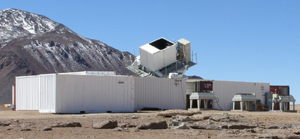Cosmic detection
By Jake Grubman, ’11
Image courtesy Argonne National Laboratory
For a fraction of a second after the big bang, space expanded faster than the speed of light. Nearly 14 billion years later, physicist Bruce Winstein and his team of researchers on the QUIET (Q/U Imaging ExperimenT) collaboration are trying to detect the faint gravity waves left over from that cataclysmic moment.
While theorists accept that rapid inflation followed the big bang, Winstein hopes to prove it. Gravity waves are produced by disturbances in the fabric of space-time as massive objects accelerate, and they carry an energy called gravitational radiation. Those earliest gravity waves have never been observed directly.

The QUIET team, collecting data on two wavelengths at once, will detect and characterize the polarization of cosmic microwave background (CMB) radiation—the afterglow of the big bang, which may bear an obscure imprint of those earliest gravity waves. Using several highly sensitive imaging arrays, QUIET analyzes space, pixel by pixel, looking for ripples in the CMB polarization pattern. Almost all CMB radiation is polarized uniformly, meaning the electromagnetic waves that make it up are oriented in the same direction. A rippled pattern would indicate that intense gravity waves had alternately expanded and compressed space. It’s “the smoking gun,” Winstein says, of a universe rapidly inflating in that primordial split-second.
Several other experiments are searching for traces of the same polarization, but QUIET’s technique is different. Using an instrument called a monolithic microwave integrated circuit to amplify the signal, it reads the electromagnetic polarization at 40 GHz and 90 GHz. Measuring two frequencies in the gravity-wave spectrum improves accuracy, and measuring them simultaneously allows QUIET to analyze the effects of the team’s techniques on the resulting readings.
To calculate this polarization requires a large number of detectors. The QUIET experiment has an antenna array of about 100 detectors, operating at an altitude of 17,000 feet in Chile’s Atacama Desert. The team hopes to mass-produce about 2,000 detectors over the next couple of years to gather better images.
Return to top